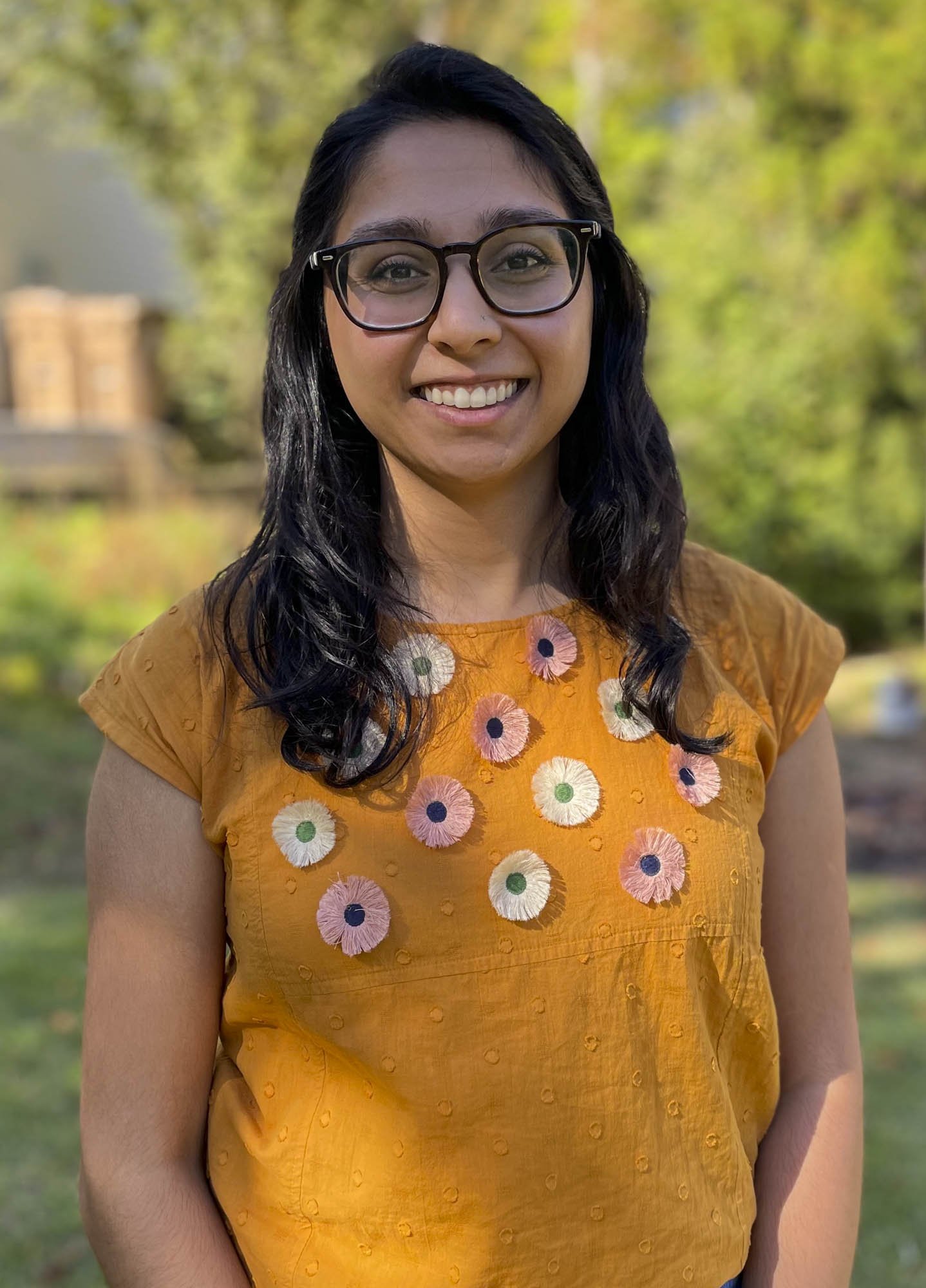Jhana Parikh
“I mean, I was born in Raleigh, North Carolina. I have never lived anywhere else. So, yeah, I'm pretty comfortable calling myself a Southerner.”
Jhana Parikh poses for a portrait outside her home in Cary, N.C. / Photo by Maydha Devarajan.
Jhana and her father, Snehal. / Photo courtesy of Jhana Parikh.
Indian immigration to North Carolina, like in other parts of the country, has come in waves.
But the explosion in growth can often be traced back to around the 1990s, when many migrants came on H-1B visas (a category of temporary visas that U.S. employers use to hire foreign professionals who are highly educated).
Between 1969 and the end of the 1980s, the South Asian population grew rapidly from around 600 to more than 8,000 people (Subramanian 2000).
For 25-year-old Jhana Parikh, her family’s story in this country begins a little earlier.
Both of Parikh’s parents were born in India (her father in Mumbai and her mother in Vadodara), but moved to the States as young kids in the late 1960s. Her mother grew up in Michigan, where Parikh’s grandfather had started a job with Ford Motor Company. Her father moved to Fuquay-Varina, North Carolina as his father started working as a physician in the town, which had a population of around 3,500 people at the time.
Photo courtesy of Jhana Parikh.
While Parikh’s parents are technically first-generation immigrants, they’ve spent essentially their entire lives in the United States, which has, in turn, informed her experiences as an essentially third-generation immigrant.
“[My parents] don't even remember anything from India,” she said. “My dad, I think, remembers a little bit, but 100% of their schooling and their education was in the United States. And so I think that it would be disingenuous to say that I had any sort of experience that wasn't third generation.”
Photo courtesy of Jhana Parikh.
Parikh and her two siblings grew up in Cary, a suburban town that is home to a huge South Asian — and, in particular, Indian — population. Cary is a treasure trove of restaurants, grocery stores and clothing shops run by those from across the diaspora. It can be easy to take for granted that community, which seemingly exists at every turn.
But even just a decade prior, Parikh notes it wasn’t always this way in her schooling experience.
She attended the Montessori School of Raleigh up until starting public school in the 7th grade. When thinking back to those classes, she remembers the student population being predominantly white and possessing a certain socioeconomic privilege.
Parikh says she remembers a time in her life where she wanted to be white. For more than a year in elementary school, she asked others to call her “Laura,” because she didn’t want to have an “Indian” name, she said.
MD: Do you remember ever feeling like you wanted to be white?
JP: Yes. And it was around that time, too. And I don't even know if I can articulate why anymore. But I think it just had a lot to do with wanting to be like the people around me.
When Parikh moved to magnet schools, she was now surrounded by people who looked like her. Her friend group went from “primarily white to primarily Asian,” she said.
And when I ask about her self-concept as a Southerner, Parikh says it’s an identifier she could claim, but also asserts that her experiences growing up in Raleigh and the suburbs are different than they would have been had she grown up in a rural town in North Carolina.
“I mean, I was born in Raleigh, North Carolina. I have never lived anywhere else. So I think, yeah, I'm pretty comfortable calling myself a Southerner.”
She graduated in 2014 from Enloe High School, the same high school that her father went to nearly 30 years prior in its first integrated class.
Parikh guesses her dad would also have similar sentiments in differentiating between “Southern from Raleigh, North Carolina versus Southern from rural North Carolina.”
In our conversation, “American” and “Indian” are other identities she positions against one another.
“I would say my identity is probably more American than Indian, but I still do identify as Indian American, and that is something that has changed a little bit over the years. I mean, especially in elementary school, very much wanting to shut off the Indian part of my identity and then starting to realize that it's important to me and it's something that I value and that my parents value and, you know, culturally, my family values a lot.”
Parikh’s mother serves as head of voter engagement for North Carolina Asian Americans Together, a nonprofit organization devoted to promoting civic engagement among the state’s Asian American populations. Parikh said part of her mother’s work involves understanding where Asian Americans fit into ideas of a Black-white binary in the South.
It’s “an interesting gray area in the middle” to consider, Parikh says.
Parikh, who graduated from UNC-Chapel Hill in 2018, lives in Cary with her family, and is completing a masters degree in physiology at N.C. State University.



